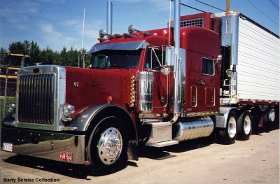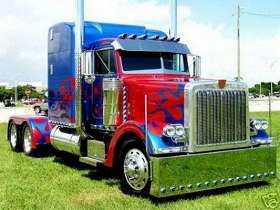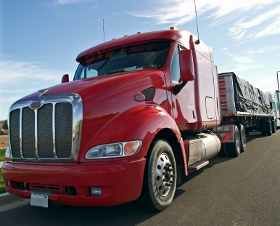Need Help With Alley Docking
Topic 12648 | Page 1
Sorry, CT, the 90 was developed by the Devil himself to torment driving students. We all need to seek out own salvation.
First, simply focus on what you're doing, don't worry about the screw up "last time" envelop to try to do better.
The tandems take about 10 feet of travel before they start to do what you want them to do, so watch the "path" for 10 feet behind them. You can't go too slow, so take your time. (I know some schools do give you a time limit, but you have to really work on it to go overtime.)
If you have a chance, get a toy truck and watch how it goes on a table top.
Then, a year into your new career, you can do this without any help: Alley Dock in Action
Tandems:
Tandem Axles
A set of axles spaced close together, legally defined as more than 40 and less than 96 inches apart by the USDOT. Drivers tend to refer to the tandem axles on their trailer as just "tandems". You might hear a driver say, "I'm 400 pounds overweight on my tandems", referring to his trailer tandems, not his tractor tandems. Tractor tandems are generally just referred to as "drives" which is short for "drive axles".
Tandem:
Tandem Axles
A set of axles spaced close together, legally defined as more than 40 and less than 96 inches apart by the USDOT. Drivers tend to refer to the tandem axles on their trailer as just "tandems". You might hear a driver say, "I'm 400 pounds overweight on my tandems", referring to his trailer tandems, not his tractor tandems. Tractor tandems are generally just referred to as "drives" which is short for "drive axles".

The best advice I have is what I do when I am on the road. LEAN WAY OUT THE WINDOW.

Like Errol said, it's about a 10foot difference from the time your tires role, to the time they do what you want them to do. Get out of the truck, stand in front of the first turning cone. Now toes to heel walk about ten paces forward. Roughly that's about 10ft. Put something down on the ground to mark it. You can do this in school but probably not on test day. NOOOOOW, get back in the drivers seat, and before you move. Look over your left shoulder and out the window. Find something that is a FIXED OBJECT and use that as your reference point. Move your truck forward, put it in reverse and when your shoulder lines up with your reference point. STOP! Cut the wheel hard to the right. The truck will role back 10feet and start to make it's way into the box. Hold the wheel until the truck jack-knifes back the truck doesn't make contact with the trailer. You'll know you are there when you continue to try and back up and your tandem trailer tires aren't doing anything. NOW, cut the wheel back to the left hard and follow the trailer into the box. Just before you are about to hit the cone and go out of bounds, stop and do a pull up until the trailer is straight. You should be able to see both sides of the cones. Then all you have to do is straight line back it in. Very simple. Good luck brother.
(this is assuming you are backing into your drivers side in a 90degree. If you are backing into the passengers side then reverse the directions)
Tandem:
Tandem Axles
A set of axles spaced close together, legally defined as more than 40 and less than 96 inches apart by the USDOT. Drivers tend to refer to the tandem axles on their trailer as just "tandems". You might hear a driver say, "I'm 400 pounds overweight on my tandems", referring to his trailer tandems, not his tractor tandems. Tractor tandems are generally just referred to as "drives" which is short for "drive axles".
The link I added just shows that after a while you'll "get it".
C.T., if you're consistently hitting the inside cone, you need to setup a couple of feet closer to the box before you start your maneuvers.
I'm not sure if your test pad is laid out the same as Missouri's, but this works on the test pads there. This is how I teach it.
There is a line painted across the pad that you will reference for the setup. Getting this right is the probably the most important point. You might need to experiment with the exact starting point to avoid going too far inside or outside. It's easier to fix if you go too far toward the far cone, because you can turn right and pull up to make it more like a slight offset or a straight line back. Going inside requires you to pull straight up or slightly left, then back at a wider angle to get the tandems in the box.
I can't remember where the reefer guys set up. I think they put the line under their front drive tire. For a flatbed, you put the line between the drives.
Once you're setup, crank the wheel all the way to the right and then back until you can see your driver's side mudflap go about three inches past the passenger side landing gear.
Stop.
Crank the wheel left until the steers are straight with the truck when you let the wheel loose (lean out the window to make sure). Then crank it left another full turn and a quarter. Keep an eye on the gap between the mudflap and the landing gear and make small adjustments left or right to maintain that gap. Hold it there and back until your trailer tandems are in front of the inside cone.
Stop.
Now crank the wheel all the way left and continue to back until the truck is straight with the trailer. You should be in the box.
Tandems:
Tandem Axles
A set of axles spaced close together, legally defined as more than 40 and less than 96 inches apart by the USDOT. Drivers tend to refer to the tandem axles on their trailer as just "tandems". You might hear a driver say, "I'm 400 pounds overweight on my tandems", referring to his trailer tandems, not his tractor tandems. Tractor tandems are generally just referred to as "drives" which is short for "drive axles".
Tandem:
Tandem Axles
A set of axles spaced close together, legally defined as more than 40 and less than 96 inches apart by the USDOT. Drivers tend to refer to the tandem axles on their trailer as just "tandems". You might hear a driver say, "I'm 400 pounds overweight on my tandems", referring to his trailer tandems, not his tractor tandems. Tractor tandems are generally just referred to as "drives" which is short for "drive axles".
Reefer:
A refrigerated trailer.
OOS:
When a violation by either a driver or company is confirmed, an out-of-service order removes either the driver or the vehicle from the roadway until the violation is corrected.
Sorry for late reply guys, had to work. I appreciate all the feedback. Tomorrow is actually our road day but we'll be back on the range Thursday. Ill give these all a shot. I forgot about using landing gear as a reference for whatever reason.

I had a lot of trouble with this even after training. When I was teaming I was able to pretty much perfect it by following my co-driver's instruction.
Pull up to the end of the trailer or spot you want as in the side your driver side will be on try to be about 5 ft away. Turn right while still rolling forward until you see the tip of the inside triangle of your landing gear. As soon as you see it turn left until you see it on the other side still moving slowly forward. Then stop and begin your backing with a right while moving back slowly. Once you're lined up give it a left and adjust as needed.
The most important part is to not immediately turn hard while backing and not completely stop while moving forward.
Another thing I learned is you can get all the advice possible but there's no substitute for practice and time.
If it happens to be for the Celadon test in Indy try to ask Miss Wendy for help. I tried 3 times with other instructors advice. One talk with her and I had no further problems on that silly test.
OWI:
Operating While Intoxicated
New Reply:
New! Check out our help videos for a better understanding of our forum features

















Preview:








 TT On Facebook
TT On Facebook
Quick question guys. Any tips on how to do a 90 degree alley dock for school? Every time I try it I'm right on that 1st cone. Maybe I'm holding it right too long? I know it takes time but I'm pretty frustrated at this point. I've got all the other maneuvers down but this one is killing me. Any help greatly appreciated.